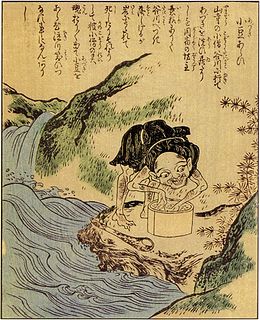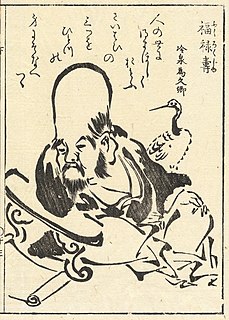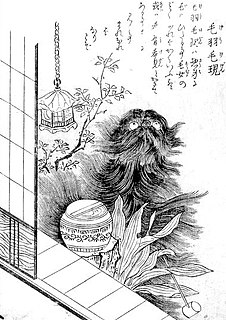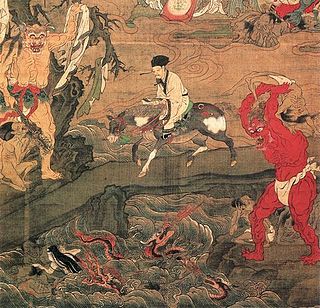 W
WAn abumi-guchi is a strange, furry yōkai, or Japanese monster, that is illustrated in Sekien Toriyama's Gazu Hyakki Tsurezure Bukuro.
 W
WThe Ainu creation myths are the traditional creation accounts of the Ainu peoples of Japan. Their stories share common characteristics with Japanese creation myths and earth diver creation stories commonly found in Central Asian and Native American cultures. Ainu mythology divides time into three tenses: "Mosir sikah ohta", "mosir noskekehe", and "mosir kes". In one version, the creator deity sends down a water wagtail to create habitable land in the watery world below. The little bird fluttered over the waters, splashing water aside, and then he packed patches of the earth firm by stomping them with his feet and beating them with his tail. In this way, islands where the Ainu were later to live were raised to float upon the ocean.
 W
WAmanozako is a monstrous goddess mentioned in the Kujiki, which states that she originated when Susanoo let his own ferocious spirit build up inside him until he vomited her out.
 W
WAmazake-babaa is an old woman yōkai from the folklore of Miyagi and Aomori prefectures. She is rumored to come to the doors of houses late at night asking for amazake in a childlike voice, but if anyone answers they fall ill. It was said that to keep her away, a cedar branch is placed in the doorway. She was also known as the goddess of smallpox in a time when smallpox ran rampant in Japan. Mothers will give offerings to amazake-babaa in order to prevent their children from falling ill.
 W
WAmefurikozō is a type of Japanese yōkai. There is a depiction of this yōkai in Sekien Toriyama's collection of yōkai drawing the Konjaku Gazu Zoku Hyakki, and they can also be seen in the kibyōshi among other publications of the same era.
 W
WAmenonuhoko is the name given to the spear in Shinto used to raise the primordial land-mass, Onogoro-shima, from the sea. It is often represented as a naginata.
 W
WAmeonna is a Japanese yōkai thought to call forth rain, illustrated in Toriyama Sekien's Konjaku Hyakki Shūi as a woman standing in the rain and licking her hand.
 W
WAoandon, or Aoandō is a creature illustrated by Toriyama Sekien in his Konjaku Hyakki Shūi. It was meant to represent the spirit that appeared during the game Hyakumonogatari Kaidankai, after the last story was told. The candles in the room during these meetings were often placed in blue-paper andon lamps in order to create an eerie atmosphere, hence this creature's name.
 W
WAosaginohi, or Aosagibi is a phenomenon illustrated by Toriyama Sekien in his Konjaku Gazu Zoku Hyakki. It depicts a night heron with a mysteriously illuminated body.
 W
WAzukiarai , or Azukitogi , is a ghostly phenomenon in Japanese folklore, in which a mysterious noise that sounds like azuki beans being washed or ground is heard. It usually occurs near a river or other body of water. Sometimes the creature or spirit responsible amuses itself by singing "azuki togou ka, hito totte kuou ka? shoki shoki.", and anyone who approaches will inevitably fall into the water.
 W
WBái Zé, or hakutaku (白澤) in Japanese is a mythical cow-like beast from Chinese legend. Its name literally means "white marsh".
 W
WThe Basan (波山), alternatively referred to as Basabasa (婆娑婆娑) or Inuhōō (犬鳳凰), is a fowl-like bird with origins stemming from Japanese mythology and folklore and illustrated in Takehara Shunsen's Ehon Hyaku Monogatari and the Gazu Hyakki Yagyō.
 W
WChimimōryō is a term that refers to monsters of the mountains and monsters of the rivers. The term originated in China roughly 2,500 years ago in ancient chronicles such as the Zuo Zhuan. It refers to various kinds of obake and things changed into yōkai. "Chimi" (魑魅) refers to the monsters of the mountains, and "mōryō" (魍魎) refers to the monsters of the river, and so the word "chimimōryō" is often used to refer to all monsters of the mountains and rivers. Furthermore, the word "minori" was also used for this. For this to be used to mean a "ripening" (minoru) oni has been used in various regions since ancient times.
 W
WDaidarabotchi (ダイダラボッチ) was a gigantic yōkai in Japanese mythology, sometimes said to pose as a mountain range when sleeping.
 W
WDatsue-ba is an old woman who sits at the edge of the Sanzu River in the Buddhist underworld. At the river, she has two primary duties.
 W
WIn Japan, Fukurokuju is one of the Seven Lucky Gods in Japanese mythology. It has been theorized that he is a Japanese assimilation of the Chinese Three Star Gods embodied in one deity. Most related in appearance to the Chinese star god Shou, he is the God of wisdom and longevity. According to some, before attaining divinity, he was a Chinese hermit of the Song Dynasty and a reincarnation of the Taoist Deity, Xuantian Shangdi. It is said that during his human incarnation, he was a sennin; a immortal who could exist without eating food.
 W
WHidari Jingorō was a possibly fictitious Japanese artist. A Renaissance man, he worked as a sculptor, carpenter, painter, architect, comedian, actor, kōdanshi and professor of art. Although various studies suggest he was active in the early Edo period, there are controversies about the historical existence of the person. Jingorō is believed to have created many famous deity sculptures located throughout Japan, and many legends have been told about him. His famous nemuri-neko carving is located above the Kuguri-mon Gate amidst the sacred mountain shrines and temples of Nikkō, Japan. Amongst these shrines and temples is Nikkō Tōshō-gū, a shrine that honors the Shōgun Tokugawa Ieyasu. The two dragon carvings at the karamon in Ueno Tōshō-gū are also attributed to him.
 W
WHitaikakushi is a white piece of triangular paper or cloth worn on the head by yūrei in Japanese folklore.
 W
WThe Isonade is an enormous, shark-like sea monster said to live off the coast of Matsuura and other places in Western Japan.
 W
WJinmenju or Ninmenju is a legendary Japanese tree in the Edo Period Konjaku Hyakki Shūi by Toriyama Sekien.
 W
WIn Japan, Jurōjin (寿老人) is one of the Seven Gods of Fortune or Shichifukujin, according to Taoist beliefs. He is the god of longevity. Jurōjin originated from the Chinese Taoist god, the Old Man of the South Pole. He is known as the immortal of the Northern Song dynasty (960–1127), and may have been a historical figure of the period. Jurōjin is identified as the personification of the Southern Polar Star. While paintings and statues of Jurōjin are considered auspicious, he never developed a following independent of the other deities Seven Gods of Fortune.
 W
WThe Karura (迦楼羅) is a divine creature with human torso and birdlike head in Japanese mythology.
 W
WKeneō (懸衣翁) is a Japanese Oni who sits at the edge of the Sanzu River in the Buddhist underworld. His name translates to clothes hanging old man. In Japanese tradition when someone dies 6 mon, an old form of currency, are placed with the body to be used as payment to enter the underworld. When a soul of an adult arrives at the river they are supposed to cross it. If they were good in their lifetime they are allowed to cross the bridge. If they were partially good they have to wade through the shallow section of the river. If they were bad during their life they are forced to swim across the deepest part of the river. Once the adult soul arrives at the river Datsue-ba forces the sinners to take off their clothes, and Keneō hangs these clothes on a riverside branch that bends to reflect the gravity of the sins. If a soul arrives without clothes, Keneō flays the person’s skin and hangs it from the tree instead. The souls that are worse in life have clothes that weigh down the branch more because they carry more water from having to swim across the river. Various levels of punishment are then performed by the pair. For those who steal, for example, Datsue-ba breaks their fingers, and together with Keneō, she ties the sinner's head to the sinner's feet. Keneō and Datsue-Ba also walk along the edge of the river and torment the souls of children that are too young to cross the river.
 W
WKeukegen is a creature illustrated in Toriyama Sekien's Konjaku Hyakki Shūi.
 W
WKisshōten, also known as Kichijōten, Kisshoutennyo (吉祥天女), Kudokuten (功徳天) is a Japanese female deity. Adapted via Buddhism from the Hindu goddess Lakshmi. Kisshoutennyo is sometimes named as one of the Seven Gods of Fortune (fukujin), replacing either Jurōjin or Fukurokuju. For example, in the 1783 edition of the Butsuzōzui compendium, Kichijōten replaces Fukurokuju as one of the seven fukujin. She is considered to be the goddess of happiness, fertility, and beauty. Kisshoutennyo's iconography is distinguished by the Nyoihōju gem (如意宝珠) in her hand, Kisshōten and the Nyoihōju gem are both represented by the symbol of the kagome.
 W
WKukurihime no Kami (菊理媛神), also Kukurihime no Mikoto (菊理媛命), is a Japanese Shinto goddess venerated as Shirayama Hime (白山比咩) at Shirayama Hime Shrine in Hakusan, Ishikawa Prefecture. She is equated with Hakusan (白山), a goddess worshipped in Kaga Province. She is mentioned in Nihongi, but not in Kojiki. She is also venerated at Yasukuni Shrine in Tokyo and at Yōrō Shrine in Gifu Prefecture. Kukuri appears very briefly during the myth of Yomi, after Izanagi used the great god Michikaeshi Ōkami to block the entry to Yomi no kuni. Her words are praised by Izanagi, but what she said to him was not recorded, which is strange, since Kukurihime is worshipped in 3,000 shrines across Japan, and was later merged with Kannon Bosatsu.
 W
WKunado-no-Kami, alternately Kunato-no-Kami, Funado-no-Kami, Funato-no-Kami, or Chimata-no-Kami, are Japanese local gods connected chiefly with protection against disaster and malicious spirits.
 W
WIn Shinto faith, Kuninotokotachi (国之常立神, Kuninotokotachi-no-Kami, in Kojiki) (国常立尊, Kuninotokotachi-no-Mikoto, in Nihonshoki) is one of the two gods born from "something like a reed that arose from the soil" when the Earth was chaotic. In the Nihon Shoki, he is the first of the first three divinities born after Heaven and Earth were born out of chaos, and is born from something looking like a reed-shoot growing between heaven and earth. He is known by mythology to reside on top of Mount Fuji (富士山).
 W
WKuro-shima (黒島) is a small, uninhabited island in the Uwa Sea off the coast of Shikoku, Japan. It belongs to the town of Ikata, Ehime Prefecture.
 W
WIn modern Japanese folklore, the Ningen is an aquatic humanoid creature reported to inhabit the subantarctic oceans. The word in Japanese 人間 (ningen) means "human". It is commonly considered to be a cryptid, a mysterious animal whose existence or survival is disputed or unsubstantiated.
 W
WIn Japanese folklore, Ōkubi (大首) are giant heads of either men or women. An Ōkubi appearing in the sky is a sign of impending disaster, which may be a typhoon, earthquake, tsunami, or fire. These disasters are often attributed to the Ōkubi. Ōkubi are otherwise harmless and will disappear soon after the first sighting. They are thought to be sky spirits who protect the sky's or people who died during a natural disaster. They are said to protect people from the natural disasters and protect the sky from demonic sky spirits. It is said if one does not pay respect for the Ōkubi, they will be turned into sky spirits and their face will appear in the sky immediately. Those who do pay respect are said to get good fortune and gifts.
 W
WŌmagatoki – a Japanese term referring to the moment at Tasogare , when the sky grows dark. The opposite of Tasogare is Akatsuki , Ōmagatoki has specific meanings for the two ways of writing it: first, "the time of meeting Yōkai, Yūrei, and other-such dark creatures"; and second, "the Time of Great Calamity".
 W
WOmoikane is a Shinto god of wisdom and intelligence. His name means "serving one's thoughts." A heavenly deity who is called upon to "ponder" and give good counsel in the deliberations of the heavenly deities. In the myth where Amaterasu hid in a cave, he was tasked to find a way to get her out.
 W
WAn onikuma is a mythological Japanese yōkai originating in the Kiso Valley in Nagano Prefecture. It is a bear-like creature that has been known to walk upright. They sneak into villages at night to carry off livestock for food. It was described in the Ehon Hyaku Monogatari, a collection of supernatural tales published in 1841.
 W
WŌyama-tsumi or Ohoyama-tsumi is a god of mountains, sea, and war in Japanese mythology. He is an elder brother of Amaterasu and Susanoo. His other names are Watashi-no-Ōkami (和多志大神) and Sakatoke (酒解神).
 W
WIn Japanese folklore, Ryūgū-jō is the undersea palace of Ryūjin, the dragon kami of the sea. Princess Otohime, her maidens, and Ryūjin's vassals reside in the palace, as well. Jinja hime are yōkai that serve in Ryūgū-jo. During the Edo period, a jinja hime reportedly appeared on a beach proclaiming to be “a messenger from Ryūgū.” With a six-meter-long, snake-like body, they resemble giant oarfish, which are called ryūgū no tsukai in Japanese.
 W
WThe Sanzu-no-Kawa is a mythological river in Japanese Buddhist tradition similar to the Hindu concept of the Vaitarna and Greek concept of the Styx.
 W
WSatori in Japanese folklore are mind-reading monkey-like monsters ("yōkai") said to dwell within the mountains of Hida and Mino.
 W
WSazae-oni are creatures from Japanese mythology, resembling large mollusks. They are a type of obake, forming when turban snails, especially Turbo cornutus, reach 30 years of age.
 W
WThe Sessho-seki , or "Killing Stone", is an object in Japanese mythology. It is said that the stone kills anyone who comes into contact with it.
 W
WA shachihoko – or simply shachi (鯱) – is an animal in Japanese folklore with the head of a tiger and the body of a carp. It was believed that this animal could cause the rain to fall, and as such, temples and castles were often adorned with roof ornaments (shibi) crafted in the form of a shachihoko, in order to protect them from fire. Those buildings were often made of wood, rendering them flammable.
 W
WShirime is a strange yōkai with an eye in the place of his anus.
 W
WShiryō (死霊) are the souls of the dead in Japanese folklore. This contrasts with ikiryō, which are souls of the living.
 W
WIn English, to "spirit away" means to remove without anyone's noticing.
 W
WTakenouchi no Sukune (武内宿禰) or Takeshiuchi no Sukune was a legendary Japanese hero-statesman of the 1st century, and a Shinto kami.
 W
WIn Japanese mythology, the tenson kōrin (天孫降臨) is the descent of Amaterasu's grandson Ninigi-no-Mikoto from Heaven (Takamagahara) to Ashihara no Nakatsukuni; according to legend, the direct place of descent is at Takachiho-gawara in Japan. Following the tenson kōrin, Ninigi's son, Hoori, was born.
 W
WA tokin is a traditional or fictional small box worn on the foreheads of Yamabushi – practitioners of Shugendō – or Tengu, dangerous yet protective spirits of the mountains and forests from the Japanese mythology.
 W
WUkanomitama is a kami in classical Japanese mythology, associated with food and agriculture, often identified with Inari, the deity of rice.
 W
WYama-no-Kami (山の神) is the name given to a kami of the mountains of the Shinto religion of Japan. These can be of two different types. The first type is a god of the mountains who is worshipped by hunters, woodcutters, and charcoal burners. The second is a god of agriculture who comes down from the mountains and is worshipped by farmers. This kami is generally considered as a goddess, or a female deity.
 W
WYata no Kagami (八咫鏡) is a sacred mirror that is part of the Imperial Regalia of Japan. It is said to be housed in Ise Grand Shrine in Mie Prefecture, Japan, although a lack of public access makes this difficult to verify. The Yata no Kagami represents "wisdom" or "honesty," depending on the source. Its name literally means "The Eight Ta Mirror," a reference to its size and octagonal shape. Mirrors in ancient Japan represented truth because they merely reflected what was shown, and were a source of much mystique and reverence. Japanese folklore is rich in stories of life before mirrors were commonplace.
 W
WYōsei is a Japanese word that is generally synonymous with the English term fairy (フェアリー). Today, this word usually refers to spirits from Western legends, but occasionally it may also denote a creature from native Japanese folklore. For example, according to an old folk belief from Iwate Prefecture, it was once feared that the yōsei could resurrect the dead. It is also mentioned that the people of Mt. Hōrai are small fairies that have no knowledge of great evil and so their hearts never grow old. The Ainu also tell of a race of small people known as the Koro-pok-guru in their folklore. Another fairy-like being from Japan is the Kijimuna, tree sprites told in the Ryukyuan religion of Okinawa.